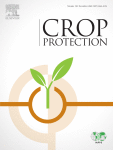Ver ítem
- xmlui.general.dspace_homeCentros e Institutos de InvestigaciónCIAP. Centro de Investigaciones AgropecuariasInstituto de Patología VegetalArtículos científicosxmlui.ArtifactBrowser.ItemViewer.trail
- Inicio
- Centros e Institutos de Investigación
- CIAP. Centro de Investigaciones Agropecuarias
- Instituto de Patología Vegetal
- Artículos científicos
- Ver ítem
Anthracnose on alfalfa caused by Colletotrichum americae-borealis in Córdoba province, Argentina
Resumen
Alfalfa is an important forage crop in Argentina, with a large area dedicated to its cultivation. However, plant diseases are a common cause of loss because they limit productivity and reduce forage quality. Anthracnose, caused by the Colletotrichum species, is one of the most important diseases affecting alfalfa worldwide. In July 2018, alfalfa plants with anthracnose symptoms were collected in commercial fields of Cordoba province, Argentina. Initially,
[ver mas...]
Alfalfa is an important forage crop in Argentina, with a large area dedicated to its cultivation. However, plant diseases are a common cause of loss because they limit productivity and reduce forage quality. Anthracnose, caused by the Colletotrichum species, is one of the most important diseases affecting alfalfa worldwide. In July 2018, alfalfa plants with anthracnose symptoms were collected in commercial fields of Cordoba province, Argentina. Initially, infected plants showed small, pale gray lesions on stems, which turned oval and developed irregular dark brown/black borders as they enlarged. Three fungal isolates were obtained from the necrotic tissues of stems and single-spore purified. Based on the morphology and multilocus phylogenetic analysis, combined sequences of the partial glyceraldehyde-3-phosphate dehydrogenase (GAPDH), histone H3 (HIS3) and actin (ACT) genes, the three isolates were identified as Colletotrichum americae-borealis. Pathogenicity testing showed these isolates were pathogenic to alfalfa and Koch's postulates were verified by re-isolating the pathogen.
[Cerrar]

Autor
Fuente
Crop Protection 148 : 105732 ( 2021)
Fecha
2021-06-06
Editorial
Elsevier
ISSN
0261-2194
Documentos Relacionados
Formato
pdf
Tipo de documento
artículo
Proyectos
(ver más)
INTA/2019-PD-E4-I090-001/2019-PD-E4-I090-001/AR./Análisis de patosistemas en cultivos agrícolas y especies forestales. Caracterización de sus componentes
Palabras Claves
Derechos de acceso
Restringido
 Excepto donde se diga explicitamente, este item se publica bajo la siguiente descripción: Creative Commons Attribution-NonCommercial-ShareAlike 2.5 Unported (CC BY-NC-SA 2.5)
Excepto donde se diga explicitamente, este item se publica bajo la siguiente descripción: Creative Commons Attribution-NonCommercial-ShareAlike 2.5 Unported (CC BY-NC-SA 2.5)

